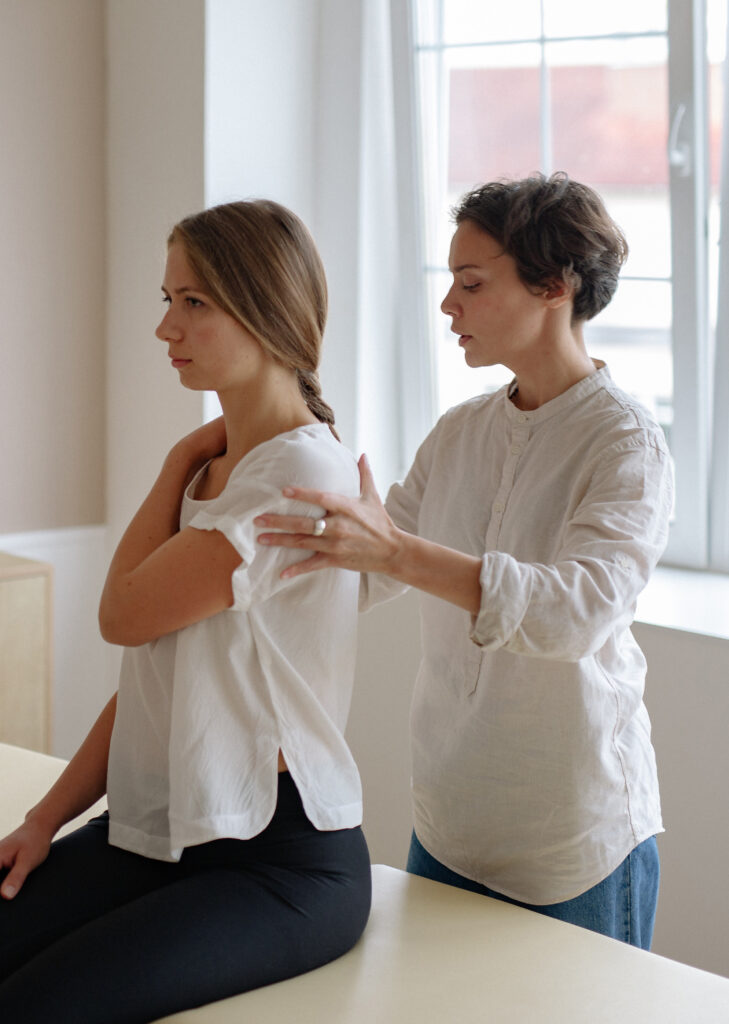Montalto Physical Therapy opened in August of 2007. As a private practice, Montalto Physical Therapy greatly appreciates the relationship it has with the members of the local community. It is this very relationship that has helped us consistently grow over the years.
Shoulder pain can arise for several reasons, unfortunately. You may feel pain in your shoulder when you’re trying to go to sleep, perhaps when you’re going for a swim, when you throw a ball, or when you reach to grab something out of your closet. Shoulder pain is tough as it limits your life considering how much we use our arms.
There are many different types of pain that you may feel in your shoulders, such as soreness of a pulled muscle or the agonizing bone-on-bone friction of when you develop arthritis. Whether your pain is severe or mild, Montalto Physical Therapy can help you. If you have been experiencing shoulder pain that’s causing limitations in your daily life, contact our physical therapy office in Tower Square at 1035 Oyster Bay Road, East Norwich to schedule a consultation and find out how Montalto Physical Therapy can bring you relief!


As you may be aware the shoulder is an intricate and complicated part of the body. Known as one of the ball-and-socket joints, meaning that the humerus (head of the upper arm bone) fits perfectly in the corresponding space within the scapula (shoulder blade). Each end of the bone is protected by a thick layer of cartilage that prevents the bones from rubbing together. The shoulder also contains fluid-filled sacs known as bursae that prevent the tendons from rubbing against the bones.
Your shoulders can accomplish several physical feats due to their structure – however, this also means that they are susceptible to an increased risk of injury because of their complexity. If something becomes damaged in the make-up of the shoulders, pain and discomfort can develop. This pain may range from a dull ache to shooting pains, depending on the severity of the condition.
If your shoulder pain is rooted from tendon impingement, you’ll typically experience pain as you lift your arms. If your pain is due to shoulder degeneration, you’ll more than likely feel persistent aches and pains when you move your arms. Shoulder pain from even the lightest injury can be sudden and intense, making the simplest of tasks difficult for you to use your shoulder.
The number of reasons why shoulder pain may develop is vast. However, some of the most common causes include:
Shoulder Dislocation.
Dislocation of the shoulder occurs when the head of the humerus pops out of place. This type of injury is extremely painful and unfortunately makes you more vulnerable to recurrence after the first dislocation occurs.
Arthritis of The Shoulder.
The two most common types of Arthritis are osteoarthritis and rheumatoid arthritis. Osteoarthritis occurs when the cartilage in the shoulder joint experiences significant “wear and tear,” typically due to age or excessive overuse. Rheumatoid arthritis occurs when the immune system sees the joints as a threat. The immune system attacks the membranes surrounding the shoulder joint, resulting in pain and inflammation.
Tendinitis of The Shoulder.
Tendinitis in the shoulder joint occurs when the joint is excessively overused, a baseball pitcher is a good example of this. The symptoms can include swelling and painful impingement when using or raising your arm. This typically happens due to the demands of a sport or labor-intensive job, which can cause the tendons to experience ongoing inflammation. This is also very common in swimmers and with other athletes.
Frozen shoulder – (you shoulder locks up)
Referred to as “adhesive capsulitis,” a frozen shoulder can occur if you have been sedentary or bedridden for a considerable amount of time. A good example is If you have had to keep your arm in a cast or sling. When you haven’t had the movement necessary or you don’t exercise the shoulder, the shoulder tissues can lock up on you, causing this painful condition to occur, but with the proper shoulder therapy you can recover from this.


Our physical therapy treatments can help manage your shoulder pain, no matter how severe it may be. Physical therapy is safe, non-invasive, and pain-free. Our licensed and dedicated physical therapists are ready to design the best-individualized treatment plan for your needs. We always want to set the right expectation and with that being said we’ve had our patients find improvement and relief after a short handful of physical therapy sessions!
For your initial visit, we do a comprehensive evaluation to properly assess the source of your pain and what direction to move forward to help you. This may include a specific testing to get a clear idea for your treatments. Your physical therapist may suggest taking X-rays to illustrate any dislocations or signs of arthritis. Range of motion tests may also be conducted in order to discover which of your soft tissues are contributing to your pain.
Once our physical therapist has created your treatment plan, you will begin working on targeted and strategic corrective exercises. Treatment plans for shoulder pain typically include gentle exercises, which have proven to reduce the stiffness of frozen shoulder and ease the pain of osteoarthritis. Strengthening programs will be implemented as a way to rehabilitate injured muscles or help stabilize a shoulder that is prone to dislocation.
Don’t let your shoulder pain impair your lifestyle, contact us today at our office in Tower Square at 1035 Oyster Bay Road, East Norwich to secure your appointment. We will manage and treat your condition so you can comfortably get back to your daily life and return to sports!
There are multiple causes that could result in shoulder pain. Trauma or an injury to the shoulder can cause pain. Over the shoulder repetitive motions can also cause shoulder pain, as your muscles, joints, and tendons are working in overdrive. While there are multiple factors that could be causing your shoulder pain, some of the most common include sprains, strains, a torn cartilage, dislocation, frozen shoulder, tendinitis, and arthritis.
Our biggest goals at Montalto Physical Therapy is to alleviate your pain and improve your ability to function correctly. Your physical therapist will work with you to make sure that both of these are achieved throughout your physical therapy sessions. Physical therapy has been proven to manage the pain of several conditions, and in many cases, it has even been proven to eliminate shoulder pain altogether, thus making the need for harmful drugs or surgical intervention obsolete.
When it comes to your upper extremities, injuries typically fall into two categories: acute or overuse. Acute injuries are caused by a single specific incident, such as a strain or tear. Overuse injuries are caused by excessive repetitive movements over time. Both acute and overuse injuries can range from mild to severe and can have a significant impact on daily life function. Shoulder pain can also be chronic, meaning it has persisted for 3 months or longer, despite efforts to relieve it. If you have been living with chronic shoulder pain, it is in your best interest to consult with a physical therapist as soon as possible, so they can get to the root of the problem and treat you accordingly.
While there is no one-stop solution for shoulder pain, there are many exercises that can be done to help strengthen the rotator cuff region and ease the pain you are expereincing. Our physical therapists are highly trained to help improve the flexibility and range of motion in your shoulder, in addition to relieving your pain and discomfort. This will be done through an individualized treatment plan designed specifically for you, including therapeutic modalities and targeted pain-relief exercises. A couple common rotator cuff-strengthening exercises that physical therapists prescribe are wall push-ups and chair push-ups. Resistance bands can also be used to increase the strength in your shoulder and help relieve pain. However, it is important to note that if your pain is serious, these exercises should not be performed without the aid of a physical therapist.